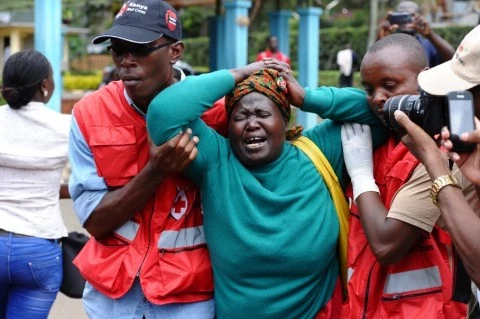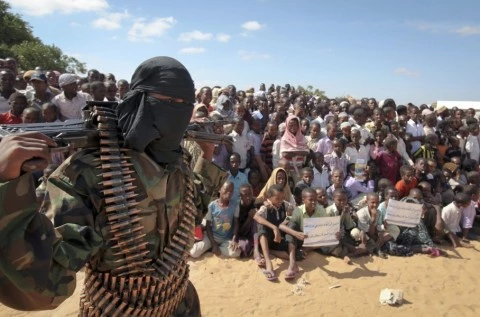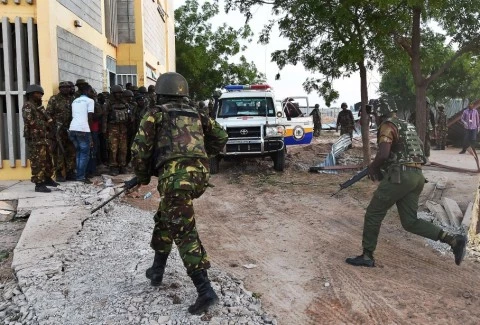
Saturday, April 4, 2015
The Islamist extremist group al-Shabab returned to international headlines this week, with a spectacular and horrific attack on the dormitories at Garissa University College in northeastern Kenya. Authorities believe that at least 147 people have died in the attack, and at least 79 people have been injured.
The militant group's dramatic return is now thought to have been the worst terror attack in Kenya in almost two decades, worse even than al-Shabab's 2013 attack on Westgate Premier Shopping Mall that left 67 people dead.

Kenya Red Cross staff assist a woman in Nairobi on April 3 after she viewed the body of a relative killed in the attack on a university in Garissa the day before. (AP)
That attack made al-Shabab internationally infamous, but in less than two years the Somalia-based group was eclipsed by the likes of the Islamic State and Boko Haram, two groups that seemed to represent a new generation of terrorism. Now it's worth asking — why is al-Shabab back? And — more importantly — did it ever really go away?
The origins of al-Shabab

An armed member of al-Shabab attends a rally in support of the merger of the Somali group with al-Qaeda on the outskirts of Mogadishu in February 2002. (AP )
Al-Shabab refers to itself as the Harakat al-Shabab al-Mujahideen: "al-Shabab" simply means "the youth" in Arabic. The group was once considered the youth militia of the Islamic Courts Union, a coalition of sharia courts that gained control of large parts of Somalia in 2006. Many analysts think the group has deeper origins in the Salafist militia Al-Ittihad Al-Islami, which emerged in the 1990s after the fall of Somalia's military dictatorship.
After the ICU was defeated by troops loyal to Somalia's transitional government and Ethiopia in 2007, al-Shabab fighters headed to the countryside, where they turned to guerrilla attacks at the suggestion of al-Qaeda. The group had some success, even occupying parts of the Somali capital of Mogadishu between 2007 and 2011. In 2008, the U.S. government designated al-Shabab a foreign terrorist organization and by 2012 the group had officially pledged allegiance to al-Qaeda's leader, Ayman al-Zawahiri. The group's violent tactics — which included stoning school girls, attacking soccer fans and carrying out beheadings — soon earned it infamy.
While the group initially focused on targets within Somalia, it gradually began making its presence known outside the country — most notably in Kenya and Uganda. Kenya appears to have particularly angered the militants by sending troops into Somalia to fight alongside the African Union and prompted some of the most bloody responses from al-Shabab. Most notoriously, on Sept. 21, 2013, a number of militia members seized control of the Westgate Mall in Nairobi, resulting in a shootout with local forces and a stand-off that lasted days. Al-Shabab later claimed responsibility for the attack, which caused the deaths of at least 67 people.
A group defeated?
The success of the Kenyan mall attack brought renewed international attention to al-Shabab: Less than a month after the attack, United States forces raided an al-Shabab compound in Barawe, Somalia, ultimately backing off because too many women and children could have been hurt. Then, in September of last year, a U.S. drone strike killed a mysterious man called Mukhtar Abu Zubeyr, also known as Godane, believed to have been the mastermind of the mall attack. Western sanctions are also aimedat the group's finances.
In a speech last year, President Obama suggested that U.S. action in Somalia was an example of a successful U.S. counterterrorism campaign. He described it as the "strategy of taking out terrorists who threaten us while supporting partners on the front lines." Yemen was also held up as an example of this policy in action.
In Somalia, it's certainly clear that al-Shabab has nowhere near the power it once had. The group was forced from the capital in 2011 and then left the economically important port of Kismayo in September 2012. Nowadays, its reach is mostly limited to rural areas. In Somalia, war-torn and chaotic for much of the past 20 years, there have been tentative signs of a return to normality in Mogadishu.
In Kenya, government officials had just days ago been downplaying the threat of terrorism posed by al-Shabab and other groups. “Kenya is as safe as any country in the world," President Uhuru Kenyatta said on Wednesdayafter controversial travel advisories from Britain and Canada. “We are now fed up with this threats that we keep getting of travel advisories."
The reality is that al-Shabab was far from gone. As WorldViews noted in December, al-Shabab's attacks had not stopped in 2014: It was suspected of being behind a series of terror strikes in neighboring Kenya, including the slaughter of non-Muslims on a bus in November. Just days before the attack in Kenya, al-Shabab claimed responsibility for an attack on a hotel in Mogadishu popular with foreigners and government officials. Officials believe at least 24 people died in that attack, including six attackers.
The reality of al-Shabab's resurgence

Kenyan Defense Forces run toward the Garissa University campus after an attack by al-Shabab. (AFP PHOTO /Carl de Souza)
Despite significant intervention in Somalia from African Union forces and targeted American strikes, al-Shabab was still able to pull off a terrible attack at Garissa University College. Right now, much of the focus on how this happened is on the Kenyan government, with Somali President Hassan Sheikh Mohamud telling the BBC that security forces between the two countries needed to coordinate their intelligence better.
In fact, just last year, Kenyan journalist Harry Misiko had highlighted a lack of regional coordination as one factor that seriously hurt Kenya's fight against terrorism. Others factors included corruption and poor equipment. Observers have complained of heavy-handed reprisals from Kenyan forces.
Al-Shabab's attacks in Kenya seem to have a dual purpose — seeking to persuade Kenyan politicians to withdraw troops from the Somalia but also fomenting religious divides within Kenya. In this week's attacks, some accounts suggested that Muslims had been separated from Christians and allowed to flee. Roughly 11 percent of Kenya's population is Islamic, and al-Shabab has found fertile ground for recruits within the country.
Al-Shabab's transnational aspirations are a problem for the U.S. too. The group is said to have attracted a number of young American recruits, and Mohammed Emwazi, the Islamic State militant better known as Jihadi John, is suspected of having attempted to join the group. U.S. officials have said that the group has tried to coordinate with other jihadist groups, including Boko Haram.
Ultimately, groups like Boko Haram and the Islamic State have diverted attention from al-Shabab, but the Somali group's continuing attacks are a reminder of just how hard it can be to stop organizations committed to guerrilla warfare and terrorism.